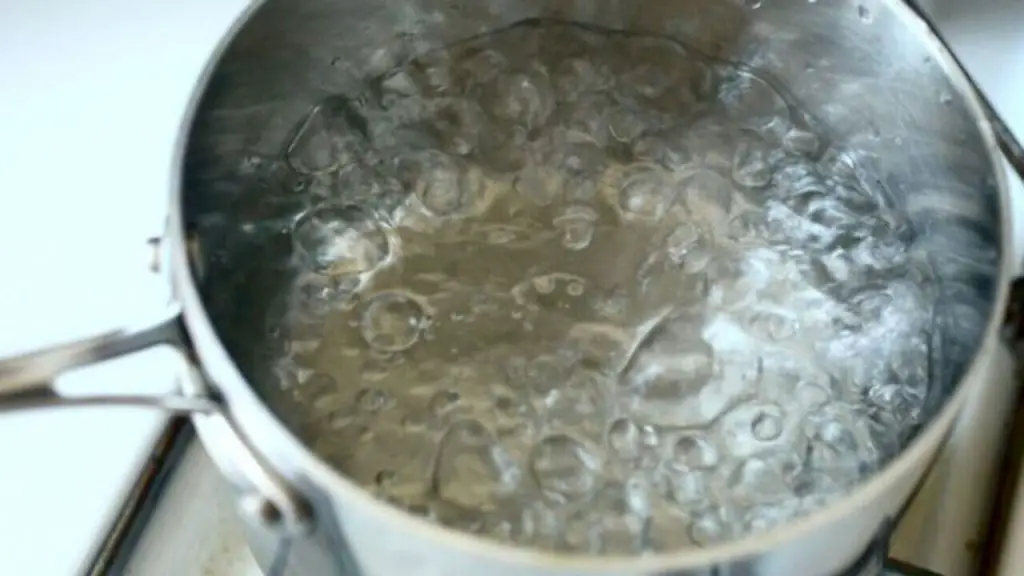Water is one of the most important elements for human beings. Not only is it necessary for drinking, but also for cooking and other household purposes.
It’s important to know how long it takes water to boil so that you can time your activities correctly and safely.

In this article, we will discuss how long it takes water to boil, quick ways to boil water, how safe it is to drink boiled water, and tips and tricks for boiling water effectively.
So, how long does it take for water to boil? On a gas burner, 6-8 minutes will suffice to boil 1 liter of standard tap water, while 9-12 minutes is required on an electric cooktop.
To boil distilled or filtered water, it takes 6 minutes on a gas stove and 8 minutes on an electric cooktop. The use of a specific pot also has an impact on how long it takes to boil water.
Quick Ways to Boil Water
Let’s say you need to boil water urgently. What would be the preferences? Let’s have a look.
1. Shallow Water
Boiling water is a typical cooking technique that novice chefs sometimes are mistaken. When you cook food in a pot of boiling water, you are only cooking in the diameter of the vessel used to prepare the meal.
Decreasing the amount of water will ensure more heat reaches the food. Remember, a shallow pan will attain the boiling temperature quickly when compared to deep pans.
The reason is the surface area. As there will be less water for the same area, heat distribution will be even and spread more quickly.
2. Appropriate Container
You may use any sort of container to boil the water, as long as there is enough room for the pot and your burner is big enough. The materials used in the container, on the other hand, will have an impact on how quickly it boils.
Stainless steel, aluminum, or copper are superior container materials to plastic or glass when attempting to boil water fast. The reason is, that metals are better conductors of heat than glass.
3. Warm Water
If you’re in a hurry, you may use boiling water from the hot faucet to fill your pot. It will boil faster than chilly or lukewarm water. You may also raise the temperature of the water in an electric kettle higher.
To begin, bring the water to a much higher temperature than what your tap water would reach. This will speed up the boiling process significantly.
Pour the water into a saucepan and bring it to a boil, stirring occasionally. This procedure will cut several minutes off of food or drink preparation time.
4. Pressure Cooker
Pressure cookers are a contemporary culinary gadget that has helped you save tonnes of time in the kitchen. It saves a lot of time by utilizing various methods to reduce the pressure in the environment, which shortens the time it takes to boil water.
Microwaves, for example, are one such device that quickly boils water in 3-4 minutes.
You’ll understand it with this simple formula. When you decrease the pressure in a container, the boiling temperature or point also reduces. Hence, it boils quickly.
5. Adding Salt or Sugar
The most frequent technique of heating liquids is to boil them in boiling water. It may also be a good method for cleaning water. However, it isn’t the most practical choice.
If you want to speed up the boiling process, one teaspoon of sugar or salt should be added. Indeed, combining culinary ingredients with boiling water is an efficient way that only a few people are aware of.
6. Putting a Lid
Have you ever questioned why the boiling point of water is 212 degrees Fahrenheit? The air in the pot heats up at the same time as the water. This heated vapor or air mixes back into the water, helping to get it to a boil quickly.
Putting a cover on top of the pot or pan to keep the vapor or air from escaping and lowering the risk of overflow is one way that may be difficult to see.
Is It Safe to Drink Boiled Water?
We discussed the “how long does it take for water to boil?” section. Let’s check if it’s actually a safer option?
Boiling water is the simplest method to ensure that water is drinkable. Water purification tablets, chlorine, and UV filters are other options, but unless you’re prepared and ready to purify water, boiling water is the most straightforward solution available.
Boiling water works well because, by the time the boiling water temperature is reached, the heat has destroyed potential harmful and unpleasant contaminants.
Boiling water is an excellent approach to destroying germs like salmonella or cholera. It’s also used to eliminate viruses and hazardous parasites.
Other pollutants, such as pesticides or chemicals, are also eliminated when the correct boiling water temperature is reached.
In a nutshell, yes, boiling water makes it safe to consume! However, in certain situations, you may also need to filter the water. This may eliminate larger particles or macro contaminants as well.
Does Boiling Purify Water Completely?
In reality, boiling water to make it safe is kind of a waste of time! However, it’s better not to take the chance by drinking it right away.
In fact, most individuals will leave their water to boil for at least one minute in order to be safe, and this is completely normal! If you’re a germaphobe, you might as well go all out and use twice-boiled water.
Remember that boiling water does not remove substantial impurities. Even if you get your water from a river or natural stream, there can still be residue or dirt in it. You’ll need to filter the contaminants out in this situation.
Furthermore, before drinking even boiled water if there is a natural disaster or the water supply is tainted with hazardous chemicals, seek advice. Some things are beyond the power of the heat to destroy.
How Long Does Various Equipment Take to Boil Water?
We’ve got a glimpse of how long does it take for water to boil? Now, let’s take a better understanding of various equipment and their time to boil water.
1. Stove
There are several myths about how long it takes to boil water on the stove. While some people believe it might take up to 10 minutes, this is not true.
Boiling water takes just 3 minutes and 30 seconds for pasta or other food that needs to be cooked in a large pot. The temperature of the liquid and its surface area-to-volume ratio influence how quickly your pot reaches boiling point.
Many individuals are unaware of a number of facts regarding boiling water on the stove. One of them is the time it takes to reach a boil in one particular pot, which is determined by the type of cookware.
Because heat travels more slowly through these pots and they deform when subjected to minor thermal shocks, a cheap thin-bottomed stainless steel pot will take longer to cook than a high-end thick-bottomed stainless steel pot.
2. Electric Kettle
Any home cook that drinks tea or instant coffee on a regular basis should have an electric kettle. The power (W) of an electric kettle is measured in watts, with kettles that are smaller and less powerful using between 1,500 and 2,200W, while bigger kettles need up to 3,000W.
A gallon of water takes 2.5 minutes to boil using an electric kettle. The time required varies depending on the manufacturer and type of kettle, as well as the water’s temperature.
An electric kettle is a device that heats water using electricity. It’s possible to fill it with either cold or hot water, depending on the desired temperature of the final product.
The power of your electric kettle can be determined by the fact of how quickly it converts cold water to hot.
3. Microwave
It takes around 2 to 3 minutes for a 900W microwave oven to reach a boil in a microwaveable plastic bowl. If you use a ceramic bowl, the water in it will stay colder for longer, preventing it from heating as quickly.
Depending on the wattage and amount of water being cooked, boiling water in the microwave takes between 1 and 3 minutes. For instance, it takes 4 minutes for 600 watts, 2 minutes for 1000 Watts, and a minute for 1200 watts.
In many cases, people rely on microwaves to boil water; nevertheless, some researchers discovered that this is a waste of time in most situations.
Microwave ovens heat food by agitating the molecules in the meal with electromagnetic waves and magnetic fields until they reach a temperature hot enough to create steam. There is no direct contact with hot water throughout the process.
Tips and Tricks When Boiling Water
Keep in mind these tips as they will come in handy in boiling water efficiently.
- Select a container that is approximately a third larger or greater than the amount of water you wish to boil.
- Put on the lid if you have one. This will assist in the boiling of the water more quickly, as well as avoid evaporated vapor loss. In a microwave oven, do not make the mistake of covering the boiling container with a lid.
- Fill the saucepan about halfway with water. Because you will lose some to evaporation and want enough left for your needs when you’re done. So, always add a little more than you need.
- If you’re doing this in the microwave, keep in mind that superheating might occur. Stir the liquid before removing it from the oven and to avoid scorching your hands, use a hot pad as a covering.
- Keep in mind that boiling makes everything considerably hotter, and you may burn yourself if you touch anything. So, make sure to have a mitt or something else to protect the hands.
Conclusion
In the end, we conclude that boiling water is not a difficult task, and it can be completed within minutes. We also discussed how long it takes for water to boil on the stove, in an electric kettle, and microwave.
Also, we discussed some easy ways with which you can quickly boil the water with salt and put a lid on top being the most efficient ones.
Plus, we also got to know that it’s safe to drink boiling and that it purifies the water considering there aren’t any large particles or macro contaminants present in it.
Furthermore, we also looked at some tips that will help you while boiling water. So, next time you need to boil water, remember all the information we’ve provided in this article.
FAQs
Is it safe to drink boiled tap water?
Yes, it is safe to drink boiled tap water. Tap water is generally safe to drink, but boiling it will remove any impurities or contaminants that may be present in the water.
Boiling water is also a good way to purify water from sources like rivers or lakes, as it will kill any harmful bacteria or parasites that may be present in the water.
How do I know water is boiling?
There are a few ways to tell if water is boiling. The most obvious way is to look for the formation of bubbles. Another way to tell if water is boiling is to touch the pot or pan with your hand.
If you feel a lot of heat coming off the pot or pan, then the water is probably boiling. Finally, you can listen to a humming sound coming from the pot or pan, which is another indication that the water is boiling.
How long does it take for an egg to boil?
It takes about three minutes for an egg to boil. The time may vary slightly depending on the size and type of egg, as well as how much water you’re using.
If you’re boiling multiple eggs, it will take longer for them to all be cooked.
What are some tips for boiling water?
Some tips for boiling water include using a pot or pan with a lid, filling the pot or pan about halfway with water, and stirring the liquid before removing it from the heat source.
It is also important to use caution when handling hot liquids, as they can cause burns. Finally, if you’re boiling water in the microwave, be sure to stir it before removing it from the oven.
Additional Contents



